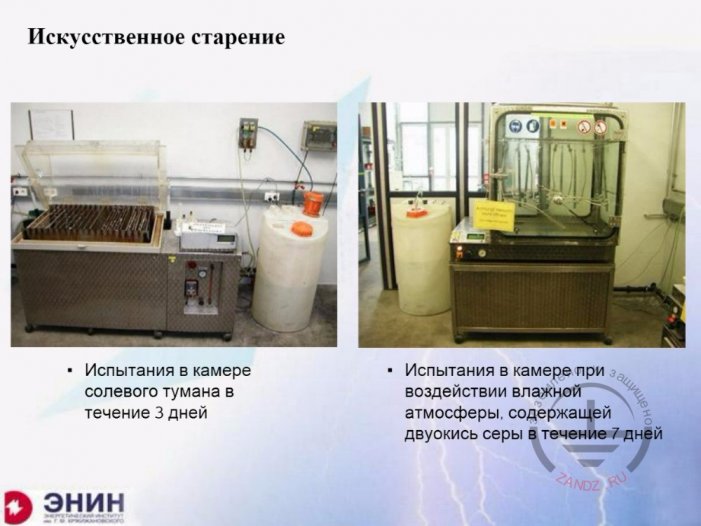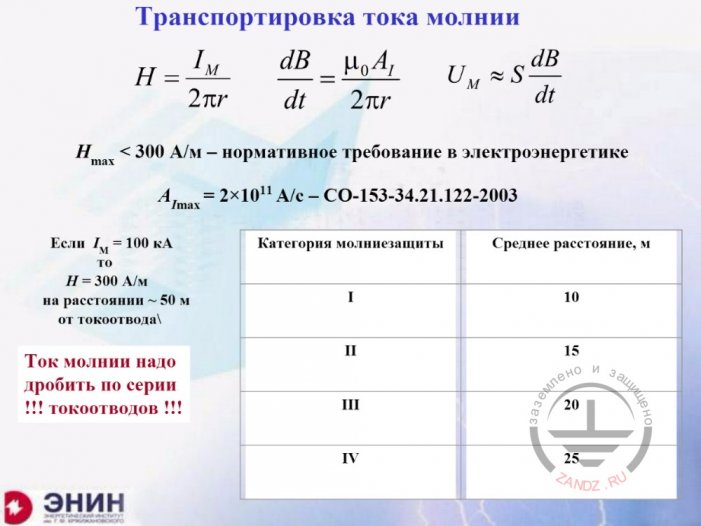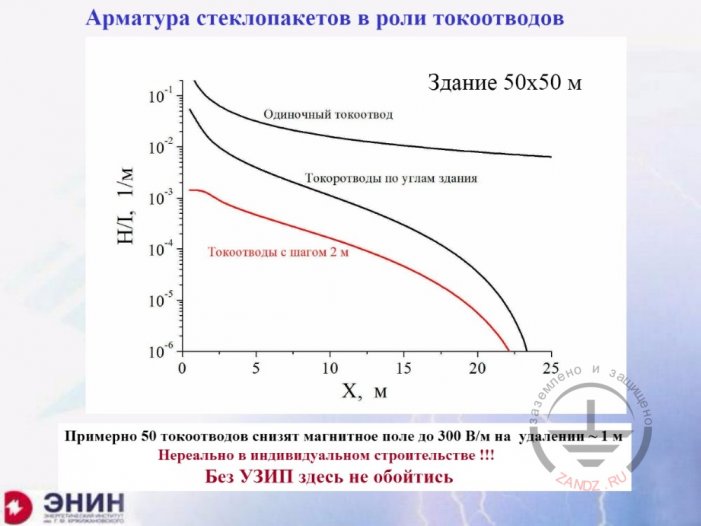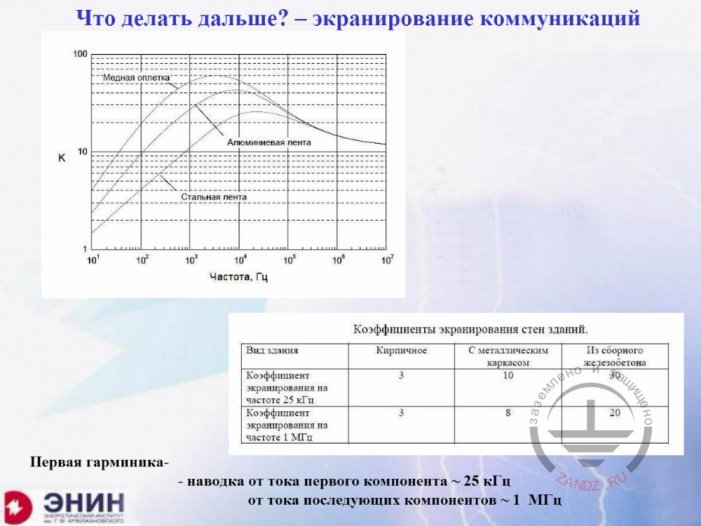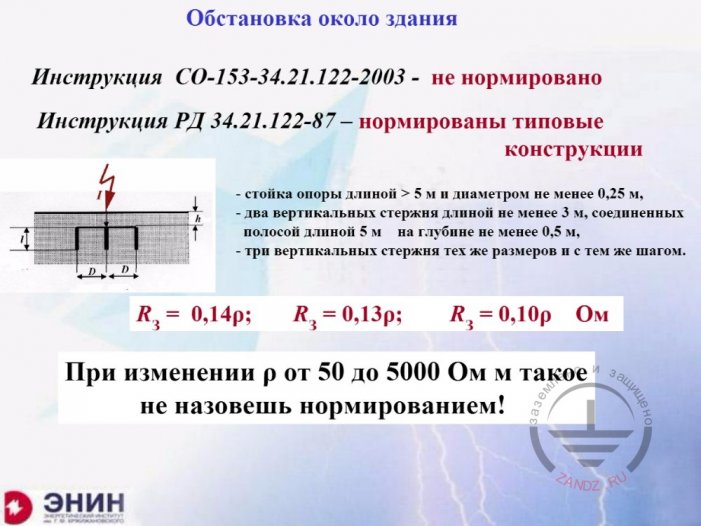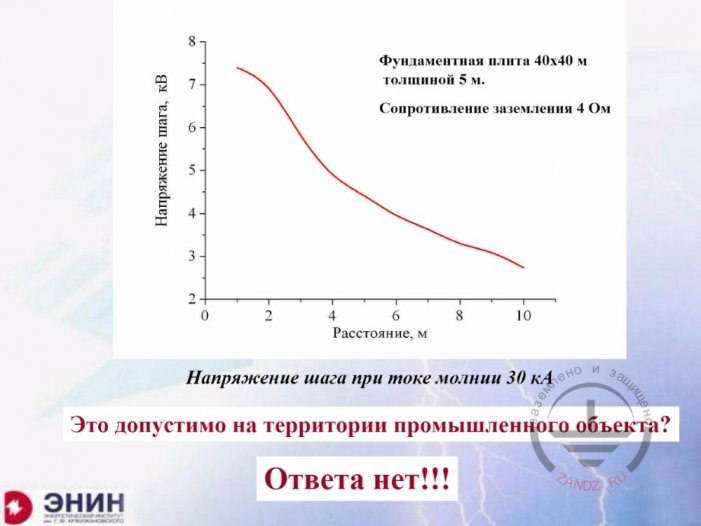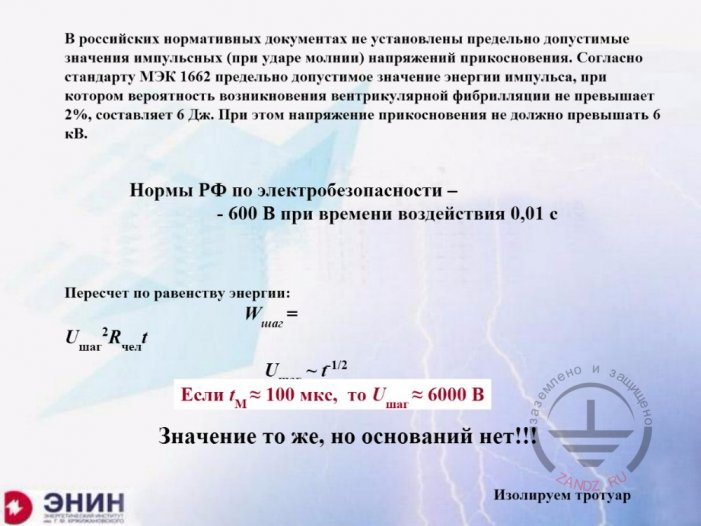The sixteenth webinar of the series "Grounding and lightning protection: questions and answers arising at the design"
Webinar text. Page 3
Quick navigation through slides:
1. For those who live on the roof
2. Useful production room
3. Regulatory requirements
4. Lightning protection of category III
5. Mesh on reinforced concrete slab
6. What do we need mesh over slabs for?
7. The difference between the standard IEC 62305 and IS 153-34.21.122-2003
8. Corona current change diagram
Artificial aging
Tests in salt fog chamber during 3 days
Tests in a humid atmosphere chamber containing sulfur dioxide during 7 days
— After that, such a connection, before hitting the market, is subject to tests. It is being tested by active liquid, which imitates acid rain and vapour banding, which imitate very strong sulphur pollution. In essence, we are talking about sulfuric acid, which is formed because of these bandings. After such a test in salt fog and liquid environment for 3 days, everything is again tested for transition resistance. And if this transition resistance doesn't reduce, it is considered that this product can hit the market. What should we do?
And such a solution is quite acceptable to my mind, until that young man, to whom I dictated the topic on roof lightning protection, finds another more constructive solution.
Lightning current transportation
Нормативное требование в электроэнергетике – regulatory requirement in electric energetics
Если Im= 100 kA то Н=30 А/м на расстоянии ~ 50 м от токоотвода – If Im= 100 kA then Н=30 А/m at the distance of ~50 m from the down condcutor
Ток молнии надо дробить по серии токоотводов – Lightning current should be split over the series of down conductors
Категория молниезащиты – lightning protection category
Среднее расстояние, м – average distance, m
— Now we are talking about transportation of lightning current with the roof. This question concerns absolutely everybody who lives or works in a building. The thing is that today a lightning strike doesn't present any special danger for a residential or office or even industrial building. The danger only comes from the magnet field of the lightning current, which creates EMF of magnetic induction in the interior space of the building. I've recently learned the regulations of the Ministry of Energy of Russia and it is written there, that if the magnet field intensity inside the building is higher than 300 A/m, then it is not allowed to mount electronic and microprocessor technical devices there. In other words, the Ministry of Energy is concerned that the electronics put inside the building will be destroyed due to electromagnetic pickups. But nobody cares about your office technical devices and household appliances; there are no requirements for that. What is 300 A/m? If to step aside from a down conductor, which is laid along the building's wall, for 1 meter, that is to the distance equal to the wall thickness, then it is necessary to divide the current over half a hundred down conductors to make it not more than 300 A/m. You will have to have 50 down conductors for that to happen. What do today's regulations state? They come to meet, because IS-153 says: if you have the I protection level, down conductors should be laid around the perimeter of the walls with the distance between them of not more than 10 meters. If it is category III - 20 meters, if category II - 15 meters. For the weakest category, IV down conductors can be laid with the distance 25 meters.
Glass units fittings as down conductors
Здание - building
Одиночный токоотвод – single down conductor
Токоотводы по углам здания – down conductors at the corners of the building
Токоотводы с шагом 2 м – down conductors with the distance of 2 m between each other
Примерно 50 токоотводов снизят магнитное поле до 300 В/м на удалении ~ 1 м – about 50 down conductors will reduce the magnet field to 300 V/m at the distance of about 1 m
Нереально в индивидуальном строительстве – Not real in individual construction
Без УЗИП здесь не обойтись – Impossible to get along without SPD
— What will it bring to? I will show you on this poster. It is estimated intensity of the field inside the building of 50 * 50 meters. What will we get with a single down conductor? And what will happen if you lay down conductors with the distance of 2 meters? The scale is logarithmical here, that's why the intensity of the magnet field inside the building will reduce to 2 orders of magnitude even at the wall itself. Where can we get down conductors with the distance of 2 meters? Who will make them? Of course you don't have to make them. What to use?
Shielding of utilities
What to do next? – shielding of utilities
медная оплетка -Copper armour
Алюминиевая лента - Aluminium tape
Стальная лента - Steel tape
Частота - Frequency
Коэффициент экранирования стен здания - Coefficient of building’s walls shielding
Вид здания - Type of building
Коэффициент экранирования на частоте 25 кГц- Coefficient of shielding at the frequency of 25 kHz
Коэффициент экранирования на частоте 1 МГц- Coefficient of shielding at the frequency of 1 MHz
Кирпич- Brick
С металлическим каркасом - With metal frame
Из сборного железобетона - Made of prefabricated concrete
— A good SPD costs about 1000$ today. It's expensive. And the second way out is to use shielding of electric circuits, connected with micro-electronics. I showed you the dependency of shielding coefficient on the signal frequency for different materials. It's a cable with copper braiding. It's a TV cable with aluminium braiding. It's a steel tape. Look that happens here. What frequency to take? For the further components of the lightning current, the equivalent signal frequency is approximately at the level of 1 million Hz and it means that the shielding frequency of any braiding becomes very low. It is on the level of 10-15, that is your signal will be weakened to 10-15 times. Will it be weakened by the walls? It will. Look, there is a chart below. For a brick building, the weakening coefficient is 3, for a building with a metal frame -10, and for a building of a prefabricated concrete the coefficient is up to 20 at the frequency of 1 million Hz. The shielding coefficients multiply and it means if you consider the coefficients of wall shielding 20 and braiding coefficient 10, your signal will be weakened 200 times more and you could live with that. Keeping in mind that everything I showed is for a building without windows. If you have windows, then you won't get any shielding at the expense of the walls, because electromagnetic emission will pierce through the big windows of a modern building.
Environment around the building
IS – 153-34.21.122-2003 – non standardized
AD 34.21.122-87 – typical structures are standardized
Tower body >5 m long and with a diameter of not less than 0,25 m
Two vertical rods not less than 3 m long, connection with a tape 5 m long at the depth of not less than 0,5 m
Three vertical rods of the same size and with the same distance between them
At the change of p from 50 to 5000 Ohm it can’t be called standardization!
— There is one moment, which we have to consider. More or less successfully I drained the lightning current to the ground. Now this lightning current will spread in the ground. And I again need it to be spreading safely. First of all, we will have to talk about a different safety, safety of people and again we did not pay special attention to it. There is nothing much about grounding in IS-153. AD 34 has information about typical ground electrode systems consisting of 2 or 3 rods with a horizontal bus. I put the calculation formulas down, which give ground resistance of such buses in case if they are lying in the ground with the resistivity ρ. If you have 3 rods which are registered in AD 34, then your ground resistance will be 0,14 and it should be multiplied to the soil resistivity. Good ground, black soil - 100 Ohm*m.
Step voltage at the lightning current of 30 kA
Напряжение шага, кВ – step voltage, kV
Фундаментная плита – foundation slab
Толщиной 5 м- 5 m thick
Сопротивление заземления 4 Ом – Grounding resistance 4 Ohm
Расстояние, м – Distance , m
Напряжение шага при токе молнии 30 кА – Step voltage at the lightning current of 30 kA
Это допустимо на территории промышленного объекта? – Is it admissible at the territory of an industrial object?
Ответа нет – There is no answer
— It brings to the fact, that people that are around this building on the pavement get under step or touch voltage, if they touch down conductor. And this voltage is the main reason of deaths of people and animals. You remember the recent case in Norway - a lot of dead reindeers. They were hit by step voltage. What is this step voltage? I took quite a favourable situation. A building 40X40m stands on a foundation slab, and this slab is very thick, it's a high-rise building and it is 5 meters deep. Ground resistance under that building is 4 Ohm. Perfect ground resistance. Any Gostekhnadzor will allow exploitation of this building. And now look, step voltage at the distance of 2 meters from this building that is on the pavement is 7 kV at the current of 30 kA - it is an average lightning current. At 100 kA you will have about 20 kV. What will happen to a human who is on this pavement during a lightning strike into the building? You remember another TV video about a Chinese guy who was falling hit by step voltage? This is it. And the question is how to regulate this value?
Electrical safety regulations of the RF
Ultimate admissible values of pulse touch voltages (at a lightning strike) are not fixed in the Russian regulatory documents . According to IEC 1662, the ultimate admissible value of impulse energy at which the probability of a ventricular fibrillation doesn’t exceed 2%, is 6 kJ. And the touch voltage should not exceed 6 kV.
Regulations of the Russian Federation on electric safety- 600V with the time of impact 0,01 Sep. 17
Calculation with the equality of energy
If t(m) = 100 ms, then Ustep = 6000 V
The value is the same, but there is no reason!!!
We insulate the pavement.
— In Russia, the regulated step voltage is only made for time impact not less than 0,01 seconds. It says that the voltage at the time impact of 0,01 is 600 V. But lightning time impact is hundred times less. What impact voltage to take? There is nothing about that in our Russian regulations. I started to search in the foreign regulations. I found in IEC 1662 that they admit transition of a charge through a human body which is equal to 6 J, thinking that the danger of heart fibrillation is not more than 2 %. This recommendation makes no sense at all. They forgot to indicate during what time period these 6 J flew through the body. If in three days, we can forget about them, but if in 1 ms, what will happen to a human? But they insist, that touch voltage should not exceed 6 kV. They do not explain where they took this figure from. But if you take these 600 V, at the regulated 0,01 s and recount according to the energy equality to time of 0,001 s, you will get a value reverse proportional to time in square root. And you will get a square root of 100 - it's 600 multiplied on 10, we will get the same 6000V stated by IEC standard. We can make this calculation, but it won't have much sense, because no high-voltage engineer knows the physiology of strong short-term currents on a human body. That is a challenging task not for the engineers but for physiologists. And the question what to do with this figure remains useless again. What can we count on? We can count on only one thing, it is better to have pavements with insulation coating at the high-rise buildings. What material is insulating today? First of all, asphalt, and it is mentioned in AD 34. Ad 34 syas that in public places at the historical monuments, churches, asphalt coating of this monument is recommended.
— Eduard Meerovich, thank you for the report. We have questions. Some of them are answered by your colleagues. One of the most popular questions in the chat is: "Does lightning protection mesh protect flat roofs, if we put it right on the roof?"
— Yes. If your roof is dielectric and under the roof there are people and technological equipment on the top level, at the normal height of the room, for instance 3 meters, the roof will securely protect equipment and people on the top floor. But if you put the coating on the reinforced concrete slabs, it won't protect these slabs at all. There is no fear that you put mesh on the slabs. But if the lightning misses and hits the reinforced concrete slab, what will happen? There will be a hole in the concrete, a piece of concrete 1-2 cm2 will come off and metal fittings will be open to the lightning current. But mesh put on a reinforced concrete slab won't protect from this event. And it should not, you understand? In fact this mesh is put only for Gostekhnadzor not to bother you.
— "The main problem of bolt connections is a frequent control of their tightening. And according to my experience, I can tell that weakening of the tightening happens every 4-6 months. How to struggle it?"
— Knowing the experience of the European countries, I can tell you one thing. What do they do? First of all, there is a possibility to make an interruption on all down conductors to measure transient resistances on down conductors. And you can put a device into these interruptions and measure transient resistances. I saw these interruptions on absolutely all buildings - this is the first thing. Now the second thing - how often do they control them?
So, everything is okay.
— "What if wind blows the rod lightning rod away together with the foundation?"
— I saw it happen.
— Eduard Meerovich, do I get it right, that at the calculation of lightning protection, wind load is considered in any case?
— No. Wind load has no influence on anything in Russia, except one thing. When we build catenary wire lightning rods to the transmission line, where the length of the catenary wire is equal to the span length and can be up to 300 m as an average figure. In this case, wind load on the wires is really considered and the electrical strength of the wire is counted considering this wind load on one side and ice load, if there is ice load in this region. For example we are talking about Kuban regions. It may happen that if to count wind load on the catenary wire, apply ice load to it, then the probability of the wire break is more frequent, then the damage of the power line due to a direct lightning strike into the wires. So in such reasons they do not hang wires. The wires remain bare. To restrict overvoltage, surge arresters are used today, which are hung parallely to the lightning chains, and remove the catenary wires, because they do not cope with such a wind load. But we are talking about a catenary wire 300 m long. Here we are talking about a rod with a maximal height 3,5 m. Compare wind loads and you will understand that these are incommensurable things.
— "Is it possible to put lightning protection mesh above the roof on concrete bases of the insulator? In fact, the material of down conductors must be corrosion-resistant. I did not find such requirements anywhere. It is easier to put such down conductors along the roof, how to justify that?"
— To what you want to raise them? This issue depends on this info. Because if I raise the mesh above the roof and put it on a decent height, then I will be able to protect everything that is on the roof with its help. I can make such an example, one company I am contacting with, faced a problem of roof protection at a highly explosive factory, where ventilation machines were standing on the roof. And such a solution was offered: take mesh from the roof, it is useless there, raise it on steel posts over the roof and above the ventilation machines, they were about 1 meter high. Raise this mesh up and use it as lightning protection. Such a solution was offered to the company owners.
— "What do you think about expertise requirements to provide lightning protection of a blow off gas pipe with a roof gas boiler house? In the USSR a blow off gas pipe had been grounded and it was prescribed to the gas workers not to make blow off in a thunderstorm. There is no function of a safety valve and now expertise requires installation of a lightning rod, which increases height of the protected object and risk of being hit by lightning".
— Unfortunately, we cannot do anything with the institutional standard on lightning protection. It is possible to mention everything in them, providing it doesn't contradict the Russian standards to the worst side. For example, the Russian standard doesn't allow to protect the zone of flammable mixtures emission, if these emissions are short-time and happen in an emergency mode. Blow off. The institutional standard of "Gazprom" for instance says this emission zone should be protected. The requirement of this protection is absolutely senseless and I can explain.
It's a silly event, but unfortunately, lightning protection specialists have to chance to struggle with it.
— "In Soviet times it was recommended to use fittings of reinforced concrete buildings as down conductors and ground electrode systems. But how to protect people from surges, who are near the walls in this case? Or maybe it's better not to use the frame of the building and put lightning rods along the walls?"
— The thing is that you can't fail to use them. You have this unblessed mesh on the building now, whether lightning hits the mesh or a reinforced concrete slab missing the mesh, which happens quite often. In any case, the current will flow along the fittings of reinforced concrete slabs and then will go to the fittings of reinforced concrete columns and walls, if they are reinforced too. Whether you want it or not, your current will flow along all fittings' rods. What will happen to people? Why people in the building won't be severely harmed? You need to count the number of fittings rods you have. You will probably count hundreds of them, and diving of the current to a great number of elements will bring to the fact, that voltage along every rod length will be significantly reduced in proportion to the number of the rods. The more rods there are, the weaker will be the surges. And that is why, there will be fewer people being hit by lightning currents flowing along the fittings of reinforced concrete slabs, columns, bases. I have never heard about such cases. Another thing if you have an individual house, for example, brick or wooden and you make down conductors along the walls of this building. You won't have a lot of such down conductors. There should be not less than 2 of them, but maybe some negligent owner will make 4.
— "Question about protection of a tile roof. The only solution is installation of a single rod or catenary wire lightning rod. However, such a roof requires individual grounding and it increases the probability of getting to the roof and its future burn-through (rafter system might ignite)".
— Let's talk about the present regulation: any metal or metallized roof can be used as a down conductor providing the thickness of the metal coating is not less than 0,5 mm. Metal tile fits the condition which was stated by EIC standard. This condition was lobbied by the producers of metal tiles. But we should say one thing: there should not be flammable elements of the system under the metal tiles. We are talking about roof timber and roof covering on which metal tiles are put, in Russia - it's wood. In Russia you necessarily have to have lightning rods, if you want a good lightning protection. But not separate lightning rods! Lightning rods must be put directly on the roof coating. It can be either catenary wire lightning rod, which goes along the ridge of the building, or you might have 2-3 rod lightning rods. Of course, they should be grounded and it is necessary to ground metal tiles on this grounding - there is such a requirement. And there are special clams to ground metal tiles; you don't have to take the protective dielectric layer off it. But if you ground metal tiles, it doesn't mean that the probability of a lightning strike will increase, because ground resistance in fact doesn't influence the frequency of lightning strikes. And if you increase the height of the building to about 1,5 meters by lightning rods, the probability of a lightning strike will increase, to about 15%. Instead of one strike in 50 years, you'll get one dangerous strike in 35 years. It is impossible to design lightning protection with such accuracy. So this danger is artificial.
— Thank you, Eduard Meerovich, for your report and answers to all questions. We are looking forward seeing you next time. The next webinar will happen on 9 November, we will talk about grounding of lightning protection at the construction sites - towers, sounding-boards, construction trailers, containers etc. It is a very interesting topic.
— But you know, Alexey and all the dear colleagues, lightning protection of roof coating is not a well examined moment yet. I did not tell you everything not because I did not want or didn't know, but because lightning protection doesn't know that. The roof problem is an unsolved task. These unsolved tasks are like a lump in throat. But what can we do?
That's it.
— Thank you, Eduard Meerovich. Dear colleagues, thank you for your participation in our webinar. You are welcome to come to the next ones. I put the link to the next webinar into the chat. Let me remind you, we will talk about construction facilities. If you have any questions about this webinar or any other questions on design of lightning protection and grounding, please send them to our email address, you can see it in the chat.
— Thank you very much for your attention! I like this communication and it is very useful for me. When you ask your questions, I understand where you have hot buttons. It is only possible to know hot buttons to lightning protection specialists in one way - to use your practical experience. We missed some things, but I can frankly tell you, that the question of the roof slope angle was not clear to me, until I started to prepare to your seminar. And then I realized. Once again, thank you! Best Regards!
— Thanks a lot to all the participants! See you soon! Good bye!
Do you have any questions left? Send them to ou technicians and you will get detailed answers.
<< Previous Page
slides from 9 to 15
Useful materials for designers:
- Webinars with the leading industry experts
- Everything for the calculation of grounding and lightning protection
- Useful materials: articles, recommendations, examples
Related Articles:
 Lightning Protection of Large Territories: Parks, Grounds, Plant Territories. Page 1
Lightning Protection of Large Territories: Parks, Grounds, Plant Territories. Page 1
 Lightning Protection of Large Territories: Parks, Grounds, Plant Territories. Page 2
Lightning Protection of Large Territories: Parks, Grounds, Plant Territories. Page 2
 Lightning Protection of Large Territories: Parks, Grounds, Plant Territories. Page 3
Lightning Protection of Large Territories: Parks, Grounds, Plant Territories. Page 3
 6. How to do that?
6. How to do that?


